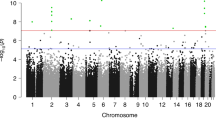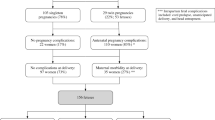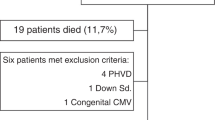Abstract
OBJECTIVE: To study the perinatal outcome of vaginally delivered twins when twin B is more than 250 g larger than twin A.
STUDY DESIGN: Maternal and neonatal charts of live-born, nonanomalous twins, >25 weeks’ gestation and vaginally delivered over a period of 17 years were reviewed. The results of this review were distributed among two groups: (1) those with twin B more than 250 g larger than twin A (ΔBW>250) and (2) those where the difference was <250 g (ΔBW<250). For vaginally delivered twin gestations, the perinatal outcome of twin B in the group ΔBW>250 was compared to that of its co-twin, and to that of twin B in the group ΔBW<250.
RESULTS: Of the 679 twin gestations reviewed, 138 (20.6%) were in the group ΔBW>250, of whom 73 (52.9%) delivered vaginally despite malpresentation in 39.7%. The vaginally delivered twin pregnancies in the groups ΔBW>250 (n=73) and ΔBW<250 (n=303) had similar demographics, parity, presentation, gestational age at delivery, and duration of the first stage of labor. Discordant twins were more frequent in the group ΔBW>250 (26.0 versus 9.5%, p=0.001). Twin B in the group ΔBW<250 was smaller, with higher incidence of growth restriction, low 5 min Apgar score, and hyperbilirubinemia compared to twin B in the group ΔBW>250. There was no difference in the incidence of intraventricular hemorrhage, seizures, sepsis, neonatal death, and median nursery stay. Except for a lower median Apgar score at 1 min in twin B and a longer median nursery stay in twin A, twins A and B in the group ΔBW>250 were similar regarding all other neonatal outcome variables.
CONCLUSIONS:When twin B is more than 250 g larger than A, and both are delivered vaginally, the perinatal outcome is similar to its co-twin as well as to that of twin B of all other vaginally delivered twins. That twin B is larger than A is not itself a contraindication to attempted vaginal delivery.
This is a preview of subscription content, access via your institution
Access options
Subscribe to this journal
Receive 12 print issues and online access
$259.00 per year
only $21.58 per issue
Buy this article
- Purchase on SpringerLink
- Instant access to full article PDF
Prices may be subject to local taxes which are calculated during checkout


Similar content being viewed by others
References
Nnatu S, Kayode Y . Relative birth weight of twins. Int J Gynaecol Obstet 1983;21(5):377–380.
Friedman EA, Sachtleben MR, Friedman LM . Relative birthweights of twins. Obstet Gynecol 1977;49(6):717–720.
Berman SM, Beinkin NJ, Hogue CJR . Assessing sex differences in neonatal survival: a study of discordant twins. Int J Epidemiol 1987;16(3):436–440.
Shepard MJ, Richards VA, Berkowitz RL, Warsof SL, Hobbins JC . An evaluation of the two equations for predicting fetal weight by ultrasound. Am J Obstet Gynecol 1982;142:47–54.
Chervenak FA, Johnson RE, Berkowitz RL, Grannum P, Hobbins JC . Is routine cesarean section necessary for vertex–breech and vertex–transverse twin gestations? Am J Obstet Gynecol 1984;148(1):1–5.
Chervenak FA, Johnson RE, Berkowitz RL, Hobbins JC . Intrapartum external version of the second twin. Obstet Gynecol 1983;62:160–165.
Fishman A, Grubb DK, Kovacs BW . Vaginal delivery of the nonvertex second twin. Am J Obstet Gynecol 1993;168:861–864.
Author information
Authors and Affiliations
Rights and permissions
About this article
Cite this article
Usta, I., Nassar, A., Abu Musa, A. et al. Perinatal Outcome of Vaginally Delivered Twin Gestations With a Larger Twin B. J Perinatol 23, 409–413 (2003). https://doi.org/10.1038/sj.jp.7210935
Published:
Issue date:
DOI: https://doi.org/10.1038/sj.jp.7210935



